
"A Mighty Fortress Is Our God" is one of the best known hymns by the Protestant Reformer Martin Luther, a prolific hymnwriter. Luther wrote the words and composed the hymn tune between 1527 and 1529. It has been translated into English at least seventy times and also into many other languages. The words are mostly original, although the first line paraphrases that of Psalm 46.

Johannes Eccard (1553–1611) was a German composer and kapellmeister. He was an early principal conductor at the Berlin court chapel.
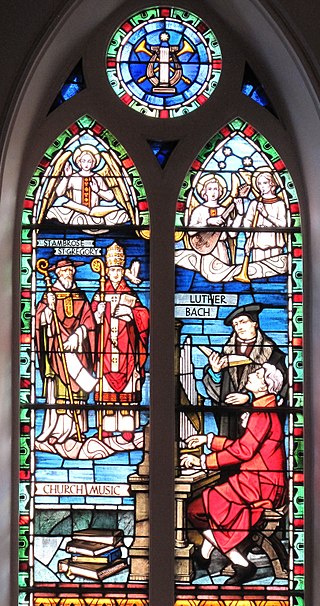
Ein feste Burg ist unser Gott, BWV 80, is a chorale cantata for Reformation Day by Johann Sebastian Bach. He reworked it from one of his Weimar cantatas, Alles, was von Gott geboren, BWV 80a. The first Leipzig version of the church cantata, BWV 80b, may have been composed as early as 1723, some five months after Bach had moved to Leipzig. Some years later he reworked the cantata one more time, writing an extended chorale fantasia as its opening movement. The text of the BWV 80a version was written by Salomon Franck and contained one stanza of Martin Luther's hymn "Ein feste Burg ist unser Gott"; for his chorale cantata versions, BWV 80b and 80, Bach added the complete text of this Lutheran hymn.

Johann Ernst Bach was a German composer of the Classical Period. He was the son of Johann Bernhard Bach.

Psalm 46 is the 46th psalm of the Book of Psalms, beginning in English in the King James Version: "God is our refuge and strength, a very present help in trouble". In the slightly different numbering system used in the Greek Septuagint and Latin Vulgate translations of the Bible, this psalm is Psalm 45. In Latin, it is known as "Deus noster refugium et virtus". The song is attributed to the sons of Korah.
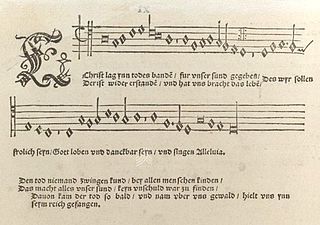
"Christ lag in Todesbanden" is an Easter hymn by Martin Luther. Its melody is by Luther and Johann Walter. Both the text and the melody were based on earlier examples. It was published in 1524 in the Erfurt Enchiridion and in Walter's choral hymnal Eyn geystlich Gesangk Buchleyn. Various composers, including Pachelbel, Bach and Telemann, have used the hymn in their compositions.

Alles, was von Gott geboren, BWV 80.1, is a church cantata by Johann Sebastian Bach. He composed it in Weimar for Oculi, the third Sunday in Lent, and first performed it on 24 March 1715 or 15 March 1716. The music is lost, but Bach expanded on it in about 1730 to create his chorale cantata for Reformation Day, Ein feste Burg ist unser Gott, BWV 80.
There are 52 chorale cantatas by Johann Sebastian Bach surviving in at least one complete version. Around 40 of these were composed during his second year as Thomaskantor in Leipzig, which started after Trinity Sunday 4 June 1724, and form the backbone of his chorale cantata cycle. The eldest known cantata by Bach, an early version of Christ lag in Todes Banden, BWV 4, presumably written in 1707, was a chorale cantata. The last chorale cantata he wrote in his second year in Leipzig was Wie schön leuchtet der Morgenstern, BWV 1, first performed on Palm Sunday, 25 March 1725. In the ten years after that he wrote at least a dozen further chorale cantatas and other cantatas that were added to his chorale cantata cycle.
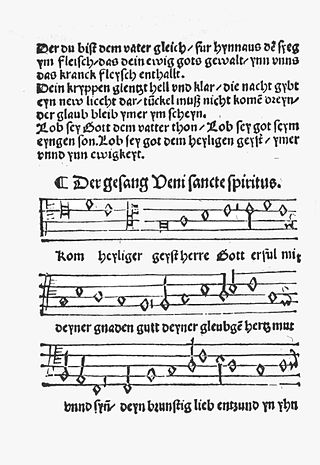
"Komm, Heiliger Geist, Herre Gott" is a Lutheran hymn for Pentecost, with words written by Martin Luther based on "Veni Sancte Spiritus, reple tuorum corda fidelium". The hymn in three stanzas was first published in 1524. For centuries the chorale has been the prominent hymn (Hauptlied) for Pentecost in German-speaking Lutheranism. Johann Sebastian Bach used it in several chorale preludes, cantatas and his motet Der Geist hilft unser Schwachheit auf, BWV 226.
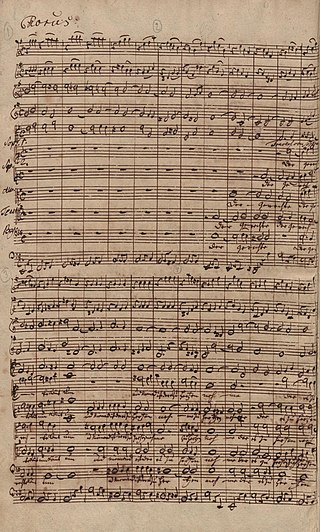
Wer ist der, so von Edom kömmt is a pasticcio Passion oratorio based on compositions by Carl Heinrich Graun, Georg Philipp Telemann, Johann Sebastian Bach and others. The pasticcio was assembled around 1750.
The Telemann-Werke-Verzeichnis, abbreviated TWV, is the numbering system identifying compositions by Georg Philipp Telemann, published by musicologist Martin Ruhnke.

"Such, wer da will, ein ander Ziel" is a Lutheran hymn in five stanzas with a text written by Georg Weissel in 1623 to a melody that Johann Stobäus had created in 1613.
Johann Sebastian Bach's chorale cantata cycle is the year-cycle of church cantatas he started composing in Leipzig from the first Sunday after Trinity in 1724. It followed the cantata cycle he had composed from his appointment as Thomaskantor after Trinity in 1723.
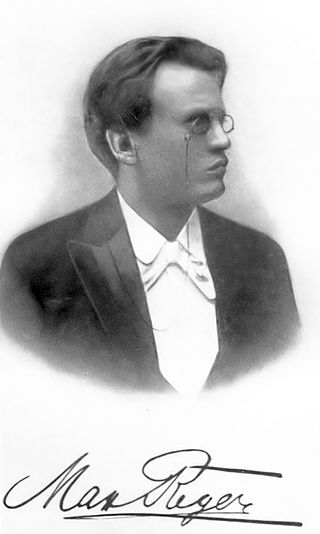
Ein' feste Burg ist unser Gott, Op. 27, is a chorale fantasia for organ by Max Reger. He composed it in 1898 on Luther's hymn "Ein feste Burg ist unser Gott". The full title is Phantasie über den Choral "Ein' feste Burg ist unser Gott".

"Was mein Gott will, das g'scheh allzeit" is a Lutheran hymn in German. The text from c. 1550 is attributed to Albert, Duke of Prussia. The melody, Zahn No. 7568, goes back to a tune by Claudin de Sermisy, written in 1529 for a secular French song. The hymn has belonged to core Lutheran hymnody without interruption and is part of the Protestant hymnal Evangelisches Gesangbuch as EG 364.

Two Motets, Op. 74, are two sacred motets for unaccompanied mixed choir by Johannes Brahms, published together. Number 1, composed in 1877 in several movements, is Warum ist das Licht gegeben dem Mühseligen?, based on Biblical texts and a chorale. Number 2, composed earlier, is O Heiland, reiß die Himmel auf, containing different settings of the stanzas of Friedrich von Spee's "O Heiland, reiß die Himmel auf". The two motets were published by N. Simrock in December 1878 and dedicated to Philipp Spitta.
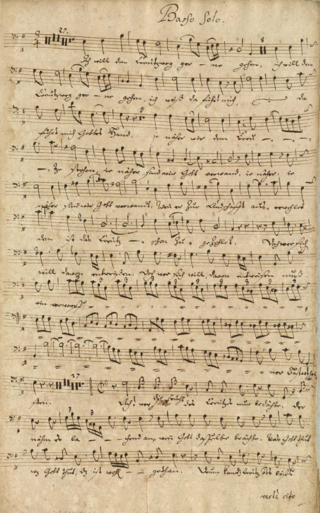
Georg Philipp Telemann composed the church cantata Ich will den Kreuzweg gerne gehen, TWV 1:884, for bass, violin and continuo for the 21st Sunday after Trinity. He used a text by Erdmann Neumeister.
Die Weihnachtsgeschichte, Op. 10, is an oratorio by Hugo Distler, composed in 1933. He set Biblical texts about the nativity of Jesus in German, interspersed with different settings of stanzas of the hymn "Es ist ein Ros entsprungen", for soloists and choir a cappella. A critical edition was published by Carus-Verlag in 2015.














